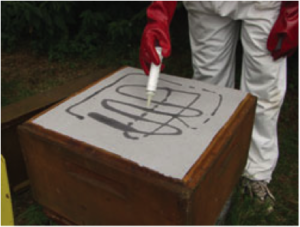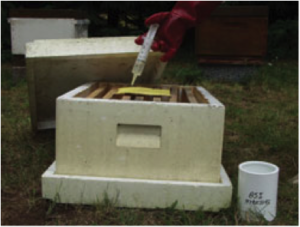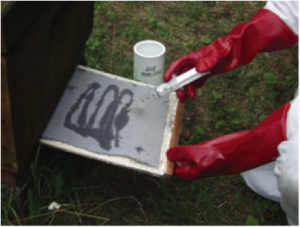Skrevet af: Flemming Vejsnæs
FORMIC ACID 1 : FREELY APPLIED
FORMIC ACID TREATMENT JUST AFTER THE HONEY HARVEST MAKES FOR HEALTHY WINTER BEES.

WHAT IS FORMIC ACID?
Formic acid is an organic acid, which occurs naturally in honey. The correct use of formic acid in the treatment of varroa mite does not provide for significant traces of the acid in the resulting honey.
THE EFFECT OF FORMIC ACID
The vapour from formic acid kills the varroa mite both on the bees and behind the sealed cells. Formic acid is today the only product that kills the mite within the sealed cell.
Formic acid is heavier than air. The bees own ventilation distributes the vapour round the hive.
Formic acid can penetrate the shell of the mite (which is many times thinner than the bees) and it destroys the skeleton, the cells and the respiratory system. The outer shell of the bees is much more resistant towards formic acid.
The oldest brood in a colony can be damaged by formic acid treatment, but normally the losses are not significant.
In rare cases formic acid treatment can result in the loss of queens. Therefore it is a good idea that replacement of queens is carried out after the completion of treatment. Normally it is the older queens (over 2 years old) that succumb.
Up until now resistance towards formic acid has not been registered, despite the fact that the product has been used for over 15 years. Since the acid attacks the mites in a number of ways, it is not to be expected that a resistance towards formic acid amongst the varroa mite will be recorded.
The effectiveness of formic acid can reach up to 95% mortality, but this varies.
SAFETY
In varroa treatment a formic acid solution of either 60 or 85% is used. These are strongly corrosive. Therefore it must be handled with care. Use rubber gloves and protective glasses. Masks are also recommended.
All activity with formic acid should be carried out outdoors, or in well ventilated rooms.
Should acid come into contact with the skin, it should be rinsed immediately with abundant water. Likewise, should it come into contact with the eye, again rinse with lots of water for at least 15 minutes, and thereafter seek medical help. Make sure always to have abundant water at the apiary.
WHERE TO BUY FORMIC ACID
At beekeepers suppliers one can purchase formic acid in a 60% solution, while an 85% soln. can be purchased at agricultural suppliers in 25 Kg. containers. Formic acid treatment is a very cheap form of treatment.
HOW AND WHEN TO USE FORMIC ACID
Formic acid treatment should take place as soon as the last honey is harvested, and the colony has got its first portion of winter feed, e.g. 7 Kg. of sugar. Formic acid treatment can either take place over four consecutive days or through the use of various vaporizers.
FOUR TIME TREATMENT
Having begun winter feeding, the acid is administered on four consecutive days using a 60% soln. on an absorbent material. It is important that the material chosen can absorb all the acid. 2 – 3 ml. of acid per frame should be used. The absorbent material can either be placed in a tray or on a plastic insert at the bottom of the hive. It is important that the acid is not more than 2 cm. from the bottom of the frames. One can also place the absorbent material on top of the frames, resting on laths. In this case it should cover the whole area, so that the bees cannot fly up.
Some beekeepers use an 85% instead of a 60% solution, which gives a stronger shock effect, but also brings a greater risk of damaging stocks. In this case smaller amounts of acid should be used. 1.5 ml. 85% formic acid soln. is equivalent to 2 ml 60% soln.
TEMPERATURE
The outdoor temperature for using formic acid should be between 12 and 25°C. If the temperature is too low an insufficient vaporization will take place and have a limited effect. Too high a temperature will result in too explosive a vaporisation and could result in damage to bees and brood.
VENTILATION
One should make sure that the only ventilation is through the entrance block. Open wire bottoms on hives should be covered.
CONTROL
If one seeks a precise mite count under formic acid treatment , the mites should be counted at the beginning and up to 12 days afterwards. This is due to the presence of dead mites behind sealed brood cells.


TREATMENT OF SEALED BROOD
Sealed brood frames from frames used for queen breeding can be treated using formic acid. The sealed brood frames without bees are placed inside a polyurethane hive for one hour with 25ml. of 85% formic acid on an absorbent material under and over the frames. Up to 7 frames can be treated in a ten frame box. The frames should be distributed evenly throughout the box. The effectiveness of this treatment is very high (close to 100%). With this form of treatment a loss of 10%of the brood can happen. especially amongst the oldest and most vulnerable .
It is important that only frames of sealed brood from colonies which are not badly damaged are used, as there otherwise could be virus present in the brood.